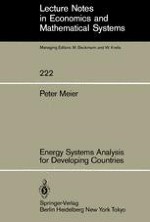1984 | OriginalPaper | Buchkapitel
Energy System Optimization Models
verfasst von : Dr. Peter Meier
Erschienen in: Energy Systems Analysis for Developing Countries
Verlag: Springer Berlin Heidelberg
Enthalten in: Professional Book Archive
Aktivieren Sie unsere intelligente Suche, um passende Fachinhalte oder Patente zu finden.
Wählen Sie Textabschnitte aus um mit Künstlicher Intelligenz passenden Patente zu finden. powered by
Markieren Sie Textabschnitte, um KI-gestützt weitere passende Inhalte zu finden. powered by
Consider the simple Reference Energy System depicted on Figure 9.1. The end use demands shown on the right, D1, D2, and D3, are assumed given (from a demand forecasting model); as in our previous discussion of Reference Energy Systems (RES) in Chapter 3, the system is demand driven. Recall that in the RES, intermediate fuel and supply variables are defined by the series of matrix transitions discussed in Section 3.2. However, the coefficients of those transition matrices, which represent the market shares of each fuel meeting end use demand categories, or the electric generation mix, require exogenous specification by the analyst — which translates, in practice, to a great deal of judgement on the part of the analyst in an attempt to bring supply and demand into balance. Indeed, in many early developing country energy assessments, such supply-demand balances were derived manually even for future years.
